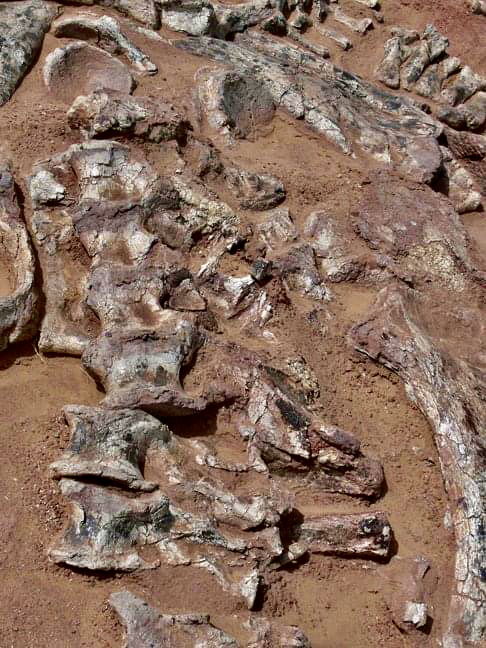Sleeping Giants of the Sahara
By Vivienne Gunning
Fossils in The Sand: Dinosaurs of Marendet
There are loud voices today — often — that claim dinosaurs never existed. That fossils are fakes, planted, invented. I am not a scientist, but I have been there. I have seen them. Touched them. Laid my body beside the bones of something that once breathed. A reminder that raw truth does not need defending when it is embedded in stone.

We were meant to be airborne… But the Sahara had other plans. Our chartered B737 had developed an “issue”, and we were suddenly stuck in Agadez for another 24 hours — no clear answers, no replacement parts, just dust, heat, and time. We had already explored the camel market, climbed the mud-brick minaret, and wandered the quiet streets of Agadez in search of distraction.
Then — a local softly whispered to me, “I can show you something... very few have seen.” And so, we left.
The road stretched straight and shimmering, a black ribbon of heat slicing through the sand. The Sahara pressed in on both shoulders — vast and silent. In the back of the vehicle, a cooler box with water, beer, and simple baguette rolls filled with Emmental cheese — small luxuries against a vast backdrop. We were dried-out and wind-chapped, having just come off three nights clamping in Berber Caidell tents, “Bushtracks Style” - These tents were made for Moroccan Royalty-white canvas shelters stitched with bold geometric motifs, breathing against the heat by day and wrapping us in warmth by night (This is as good as it gets in the desert). And now we were heading into a place where time did not just stand still — it had fossilised.

There was one lone “guard” seated under a sun-bleached white canvas shelter, its edges flapping gently in the wind. He watched over this sand filled “field of giants” with a quiet that suited the place. No crowds. No ticket booth. Just dust, sky, and 135 million years of memory. This was about 60 km from Agadez, near the small desert village of Marendet — one of West Africa’s most overlooked fossil fields. At the base of the Tiguidit escarpment — a long wall of eroded sandstone cliffs — ancient forgotten bones emerge from the sand. And not just fragments. Whole sections of dinosaurs: femurs longer than your arm span and vertebrae lost in the sand. I lay down next to one — not for scale, but for awe. A thighbone of something that walked here before birds, before flowers, before the continents were even in the same place. These fossils near Marendet is believe to belong to the Tiourarén Formation, a layer of red and violet mudstones and siltstones dating back over 160 million years — Middle to Late Jurassic. These fossils come from a time when this now-desert region was a humid, seasonally flooded plain teeming with prehistoric life. Long before the desert, dinosaurs roamed river valleys and forests now buried beneath sand.
Back then, this part of Niger sat much closer to the equator. North Africa was green and wet — part of a massive supercontinent called Gondwana. Over millions of years, the land slowly drifted north, the climate dried, and the Sahara as we know it today began to form.Scientists have uncovered nearby:
- Jobaria tiguidensis, a gentle giant of a sauropod with an unusually short neck,
- Afrovenator, a two-legged predator with curved claws and speed,
- Fossilised crocodiles, turtles, and fish.
But here, at Marendet, there were no fences, no signs, no museum boards. Just bone and wind. Just a local who knew how to find what the earth quietly holds.

It humbled me. Because in that moment, I did not just see prehistory. I felt it. A stillness so old it made your heartbeat sound loud.… and I thought: Three generations from now, will my grandchildren even know my name? And yet, these bones — this leg, this spine — may still be here. Weathered, yes. But real. Fossilised into the earth, while I will have quietly returned to it — not carved into rock, but scattered as dust.
Agadez itself is unlike any other place — a desert city of mud walls and quiet resilience. Often called the gateway to the Sahara, it has long been a crossroads of caravans, Tuareg culture, and trans-Saharan trade. Its famous mud-brick minaret, the tallest of its kind in the world, rises like a beacon above the small town. Here, history is not sealed in glass cases — it is lived, whispered, and carved into the fading architecture of a place that has weathered both time and sandstorms.
Have you been to Marendet or studied the Tiourarén Formation? I would love to hear from anyone with more knowledge, memories, or insights. Whether you are a geologist, traveller, paleontologist — or simply curious about stories — feel free to share your thoughts.
Sometimes it is not just the bones we uncover…
It is the conversations they spark